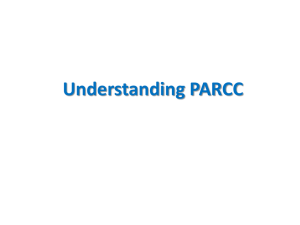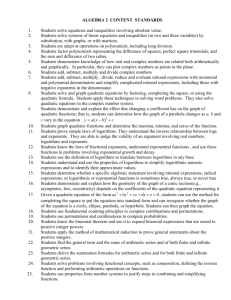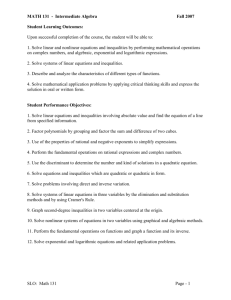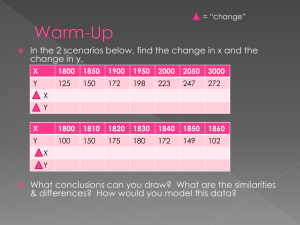Algebra I - East Poinsett County School District
advertisement
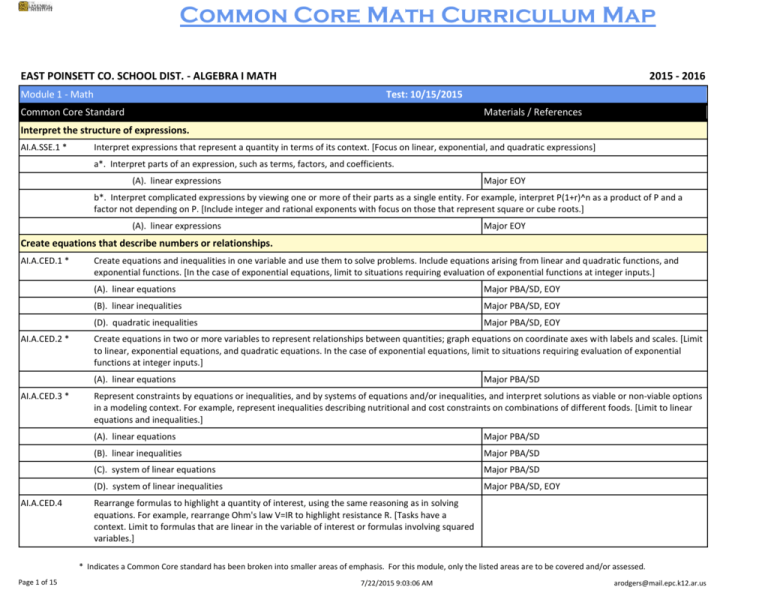
Common Core Math Curriculum Map EAST POINSETT CO. SCHOOL DIST. - ALGEBRA I MATH Module 1 - Math 2015 - 2016 Test: 10/15/2015 Common Core Standard Materials / References Interpret the structure of expressions. AI.A.SSE.1 * Interpret expressions that represent a quantity in terms of its context. [Focus on linear, exponential, and quadratic expressions] a*. Interpret parts of an expression, such as terms, factors, and coefficients. (A). linear expressions Major EOY b*. Interpret complicated expressions by viewing one or more of their parts as a single entity. For example, interpret P(1+r)^n as a product of P and a factor not depending on P. [Include integer and rational exponents with focus on those that represent square or cube roots.] (A). linear expressions Major EOY Create equations that describe numbers or relationships. AI.A.CED.1 * AI.A.CED.2 * Create equations and inequalities in one variable and use them to solve problems. Include equations arising from linear and quadratic functions, and exponential functions. [In the case of exponential equations, limit to situations requiring evaluation of exponential functions at integer inputs.] (A). linear equations Major PBA/SD, EOY (B). linear inequalities Major PBA/SD, EOY (D). quadratic inequalities Major PBA/SD, EOY Create equations in two or more variables to represent relationships between quantities; graph equations on coordinate axes with labels and scales. [Limit to linear, exponential equations, and quadratic equations. In the case of exponential equations, limit to situations requiring evaluation of exponential functions at integer inputs.] (A). linear equations AI.A.CED.3 * AI.A.CED.4 Major PBA/SD Represent constraints by equations or inequalities, and by systems of equations and/or inequalities, and interpret solutions as viable or non-viable options in a modeling context. For example, represent inequalities describing nutritional and cost constraints on combinations of different foods. [Limit to linear equations and inequalities.] (A). linear equations Major PBA/SD (B). linear inequalities Major PBA/SD (C). system of linear equations Major PBA/SD (D). system of linear inequalities Major PBA/SD, EOY Rearrange formulas to highlight a quantity of interest, using the same reasoning as in solving equations. For example, rearrange Ohm's law V=IR to highlight resistance R. [Tasks have a context. Limit to formulas that are linear in the variable of interest or formulas involving squared variables.] * Indicates a Common Core standard has been broken into smaller areas of emphasis. For this module, only the listed areas are to be covered and/or assessed. Page 1 of 15 7/22/2015 9:03:06 AM arodgers@mail.epc.k12.ar.us Common Core Math Curriculum Map Solve equations and inequalities in one variable. AI.A.REI.3 * Solve linear equations and inequalities in one variable, including equations with coefficients represented by letters. [Include simple exponential equations that rely only on application of the laws of exponents such as 5^x=125 or 2^x=1/16] (A). linear and literal equations Major EOY (B). linear inequalities Major EOY (C). exponential equations Major PBA/SD Represent and solve equations and inequalities graphically. AI.A.REI.10 * AI.A.REI.12 * Understand that the graph of an equation in two variables is the set of all its solutions plotted in the coordinate plane, often forming a curve (which could be a line). [Focus on linear and exponential equations.] (A). linear equations Major PBA, PBA/SC; This involves more than matching a graph to an equation. This involves identifying the solution set of an equation. (B). exponential equations Major PBA, PBA/SC; This involves more than matching a graph to an equation. This involves identifying the solution set of an equation. Graph the solutions to a linear inequality in two variables as half-plane (excluding the boundary in the case of a strict inequality), and graph the solution set to a system of linear inequalities in two variables as the intersection of the corresponding half-planes. (A). linear inequality Major PBA, PBA/SC & SD, EOY (B). system of linear inequalities Major PBA, PBA/SC & SD, EOY Reason quantitatively and use units to solve problems. AI.N.Q.1 * Use units as a way to understand problems and to guide the solution of multi-step problems; choose and interpret units consistently in formulas; choose and interpret the scale and the origin in graphs and data displays. (A). units Supporting PBA/SD (B). scale and origin Supporting PBA/SD Perform arithmetic operations on polynomials. AI.A.APR.1 * Understand that polynomials form a system analogous to the integers namely, they are closed under the operations of addition, subtraction, and multiplication; add, subtract, and multiply polynomials. [Focus on polynomial expressions that simplify to forms that are linear or quadratic in a positive integer power of x.] (A). addition and subtraction Major PBA, PBA/SC, EOY (B). multiplication Major PBA, PBA/SC, EOY Understand solving equations as a process of reasoning and explain the reasoning. AI.A.REI.1 Explain each step in solving a simple equation as following from the equality of numbers asserted Major PBA/SC at the previous step, starting from the assumption that the original equation has a solution. Construct a viable argument to justify a solution method. [Tasks are limited to quadratic * Indicates a Common Core standard has been broken into smaller areas of emphasis. For this module, only the listed areas are to be covered and/or assessed. Page 2 of 15 7/22/2015 9:03:06 AM arodgers@mail.epc.k12.ar.us Common Core Math Curriculum Map equations.] Solve systems of equations. AI.A.REI.5 Prove that, given a system of two equations in two variables, replacing one equation by the sum of that equation and a multiple of the other produces a system with the same solutions. [Include systems of equations that yield infinitely many solutions and no solutions.] Additional PBA/SC; Focus on two variable systems of equations and inequalities. Incorporate slope criteria for parallel and perpendicular lines (8.Critical Area 2) AI.A.REI.6(A) Solve multi-step contextual problems that require writing and analyzing systems of linear equations exactly and approximately (e.g., with graphs), focusing on pairs of linear equations in two variables. [Tasks have a real world context.] Pairs of linear equations in two unknowns Additiona PBA/SD, EOY; Use graphing, algebraic (i.e., elimination, substitution), modeling (i.e., algebra tiles) and technological methods. Summarize, represent, and interpret data on a single count or measurement variable. AI.S.ID.1 Represent data with plots on the real number line (dot plots, histograms, and box plots). Additional EOY AI.S.ID.2 Use statistics appropriate to the shape of the data distribution to compare center (median, mean) Additional EOY and spread (interquartile range, standard deviation) of two or more different data sets. AI.S.ID.3 Interpret differences in shape, center, and spread in the context of data sets, accounting for possible effects of extreme data points (outliers). Additional EOY Summarize, represent, and interpret data on two categorical and quantitative variables. AI.S.ID.5 Summarize categorical data for two categories in two-way frequency tables. Interpret relative frequencies in the context of the data (including joint, marginal, and conditional relative frequencies). Recognize possible associations and trends in the data Supporting EOY; Given two categorical variables whose values have been paired, a list of the frequencies of the paired values can be represented in a two -way frequency table. A joint relative frequency is found by dividing a frequency that is not in the Total row or the Total column by the grand total. A marginal relative frequency is found by dividing a row total or a column total by the grand total. A two-way, relative frequency table displays both joint relative frequencies and marginal relative frequencies. A conditional relative frequency is found by dividing a frequency that is not in the Total row or the Total column by the frequency's row total or column total. AI.S.ID.6 * Represent data on two quantitative variables on a scatter plot, and describe how the variables are related. a*. Fit a function to the data; use functions fitted to data to solve problems in the context of the data. Use given functions or choose a function suggested by the context. Emphasize linear, quadratic, and exponential models. [Tasks have a real-world context.] (A). linear functions Supporting EOY (B). exponential functions [Exponential functions are limited to those with domains in the integers.] Supporting EOY (C). quadratic functions Supporting EOY b*. Informally assess the fit of a function by plotting and analyzing residuals. [Focus on linear models, but may be used to preview quadratic functions.] (A). linear functions Supporting EOY * Indicates a Common Core standard has been broken into smaller areas of emphasis. For this module, only the listed areas are to be covered and/or assessed. Page 3 of 15 7/22/2015 9:03:06 AM arodgers@mail.epc.k12.ar.us Common Core Math Curriculum Map c. Fit a linear function for a scatter plot that suggests a linear association. Supporting EOY Interpret linear models. AI.S.ID.7 Interpret the slope (rate of change) and the intercept (constant term) of a linear model in the context of the data. Major EOY AI.S.ID.8 Compute (using technology) and interpret the correlation coefficient of a linear fit. Major EOY; See alignment note below about strength correlation. AI.S.ID.9 Distinguish between correlation and causation. Major EOY 35 testable standards End of Module 1 * Indicates a Common Core standard has been broken into smaller areas of emphasis. For this module, only the listed areas are to be covered and/or assessed. Page 4 of 15 7/22/2015 9:03:06 AM arodgers@mail.epc.k12.ar.us Common Core Math Curriculum Map EAST POINSETT CO. SCHOOL DIST. - ALGEBRA I MATH 2015 - 2016 Module 2 - Math Test: 12/3/2015 Common Core Standard Materials / References Create equations that describe numbers or relationships. AI.A.CED.1 * AI.A.CED.2 * Create equations and inequalities in one variable and use them to solve problems. Include equations arising from linear and quadratic functions, and exponential functions. [In the case of exponential equations, limit to situations requiring evaluation of exponential functions at integer inputs.] (E). exponential equations [Tasks are limited to exponential equations with integer exponents.] Major PBA/SD, EOY (F). exponential inequalities Major PBA/SD, EOY (G). absolute value equations Major PBA/SD (H). absolute value inequalities Major PBA/SD Create equations in two or more variables to represent relationships between quantities; graph equations on coordinate axes with labels and scales. [Limit to linear, exponential equations, and quadratic equations. In the case of exponential equations, limit to situations requiring evaluation of exponential functions at integer inputs.] (B). exponential equations Major PBA/SD Interpret the structure of expressions. AI.A.SSE.1 * Interpret expressions that represent a quantity in terms of its context. [Focus on linear, exponential, and quadratic expressions] a*. Interpret parts of an expression, such as terms, factors, and coefficients. (B). exponential expressions Major EOY b*. Interpret complicated expressions by viewing one or more of their parts as a single entity. For example, interpret P(1+r)^n as a product of P and a factor not depending on P. [Include integer and rational exponents with focus on those that represent square or cube roots.] (B). exponential expressions with integer and rational exponents AI.A.SSE.3 * Major EOY; Use parent function, transformation form, interest rate form. Choose and produce an equivalent form of an expression to reveal and explain properties of the quantity represented by the expression. [Include quadratic and exponential expressions] c. Use the properties of exponents to transform expressions for exponential functions. For example the expression 1.15^t can be rewritten as (1.15^(1/12))^(12t) = 1.012^(12t) to reveal the approximate equivalent monthly interest rate if the annual rate is 15%. [Tasks have a realworld context. Tasks are limited to exponential expressions with integer exponents.] Supporting PBA/SD, EOY Understand the concept of a function and use function notation. AI.F.IF.1 Understand that a function from one set (called the domain) to another set (called the range) Major PBA, EOY; Distinguish between functions and assigns to each element of the domain exactly one element of the range. If f is a function and x is relations. an element of its domain, then f(x) denotes the output of f corresponding to the input x. The * Indicates a Common Core standard has been broken into smaller areas of emphasis. For this module, only the listed areas are to be covered and/or assessed. Page 5 of 15 7/22/2015 9:03:06 AM arodgers@mail.epc.k12.ar.us Common Core Math Curriculum Map graph of f is the graph of y=f(x). [Focus on linear and exponential functions] AI.F.IF.2 Use function notation, evaluate functions for inputs in their domains, and interpret statements that use function notation in terms of a context. [Focus on linear and exponential functions] Major EOY; Review order of operations. AI.F.IF.3 Recognize that sequences are functions, sometimes defined recursively, whose domain is a subset of the integers. For example, the Fibonacci sequence is defined recursively by f(0) = f(1) = 1, f(n+1) = f(n) + f(n-1) for n is greater than or equal to 1. [Emphasize arithmetic and geometric sequences as examples of linear and exponential functions.] Major EOY Interpret functions that arise in applications in terms of the context. AI.F.IF.4 * AI.F.IF.5 * AI.F.IF.6 * For a function that models a relationship between two quantities, interpret key features of graphs and tables in terms of the quantities, and sketch graphs showing key features given a verbal description of the relationship. Key features include: intercepts; intervals where the function is increasing, decreasing, positive, or negative; relative maximums and minimums; symmetries; and end behavior. [Tasks have a real-world context. Tasks are limited to linear functions, quadratic functions, square root functions, cube root functions, piecewise-defined functions (including step functions and absolute value functions), and exponential functions with domains in the integers.] (A). linear functions Major PBA/SD, EOY (B). exponential functions Major PBA/SD, EOY (E). step and piecewise-defined functions including absolute value Major Subclaim A (EOY or PBA) Relate the domain of a function to its graph and, where applicable, to the quantitative relationship it describes, limiting to linear functions, square root functions, cube root functions, piece-wise defined functions (including step functions and absolute functions), and exponential functions with domains in the integers. For example, if the function h(n) gives the number of person-hours it takes to assemble n engines in a factory, then the positive integers would be an appropriate domain for the function. [Tasks have a real-world context.] (A). linear functions Major PBA/SD, EOY (B). exponential functions Major PBA/SD, EOY Calculate and interpret the average rate of change of a function (presented symbolically or as a table) over a specified interval. Estimate the rate of change from a graph. [Tasks have a real-world context. Tasks are limited to linear functions, quadratic functions, square root functions, cube root functions, piecewise-defined functions (including step functions and absolute value functions), and exponential functions with domains in the integers.] (A). linear functions Major PBA, PBA/SD, EOY (B). exponential functions Major PBA, PBA/SD, EOY; Introduce and teach in module 3, but will be assessed in module 4 Analyze functions using different representations. AI.F.IF.7 * Graph functions expressed symbolically and show key features of the graph, by hand in simple cases and using technology for more complicated cases. [Include linear, exponential, quadratic, absolute value, step, piece-wise defined functions.] Disontinuities are allowed as key features of the graph. a*. Graph linear and quadratic functions and show intercepts, maxima, and minima. (A). linear functions Supporting PBA, PBA/SD, EOY b*. Graph square root, cube root, and piecewise-defined functions, including step functions and absolute value functions. [Compare and contrast absolute value, step and piecewise-defined functions with linear, quadratic, and exponential functions. Highlight issues of domain, range, and usefulness when examining piecewise-defined functions.] * Indicates a Common Core standard has been broken into smaller areas of emphasis. For this module, only the listed areas are to be covered and/or assessed. Page 6 of 15 7/22/2015 9:03:06 AM arodgers@mail.epc.k12.ar.us Common Core Math Curriculum Map (B). step and piecewise-defined functions including absolute value AI.F.IF.9 * Supporting EOY Compare properties of two functions each represented in a different way (algebraically, graphically, numerically in tables, or by verbal descriptions). For example, given a graph of one quadratic function and an algebraic expression for another, say which has the larger maximum. [Tasks are limited to linear functions, quadratic functions, square root functions, cube root functions, piece-wise defined functions (including step functions and absolute value functions), and exponential functions with domains in the integers.]Tasks have real world context. (A). linear functions Supporting EOY (B). exponential functions Supporting EOY (E). step and piecewise-defined functions including absolute value Supporting EOY Build new functions from existing functions. AI.F.BF.3 * Identify the effect on the graph of replacing f(x) by f(x) + k, k f(x), f(kx), and f(x+k) for specific values of k (both positive and negative); find the value of k given the graphs. Experiment with cases and illustrate an explanation of the effects on the graph using technology. Include recognizing even and odd functions from their graphs and algebraic expressions for them. [Tasks are limited to linear functions, quadratic functions, square root functions, cube root functions, piece-wise defined functions (including step functions and absolute value functions), and exponential functions with domains in the integers. Tasks may involve more than one transformation. Tasks do not involve recognizing even and odd functions.] (A). linear functions Additional PBA/SC & SD, EOY (B). exponential functions Additional PBA/SC (D). step and piecewise-defined functions including absolute value functions Additional SubClaim B (PBA or EOY) Construct and compare linear, quadratic, and exponential models and solve problems. AI.F.LE.3 * Observe using graphs and tables that a quantity increasing exponentially eventually exceeds a quantity increasing linearly, quadratically, or (more generally) as a polynomial function. [Include comparison between linear and exponential models as well as compare linear and exponential growth to quadratic growth.] (A). compare linear and exponential models Supporting EOY (B). compare linear and exponential growth to quadratic growth Supporting EOY Interpret expressions for functions in terms of the situation they model. AI.F.LE.5 * Interpret the parameters in a linear or exponential function in terms of a context. [Limit exponential functions to those of the form f(x)=b^x+k.][Tasks have a real-world context.] (A). linear functions Supporting EOY (B). exponential functions [Exponential functions are limited to those with domains in the integers.] Supporting EOY 29 testable standards End of Module 2 ALIGNMENT NOTES AI.S.ID.8 Strength of Correlation * Indicates a Common Core standard has been broken into smaller areas of emphasis. For this module, only the listed areas are to be covered and/or assessed. Page 7 of 15 7/22/2015 9:03:06 AM arodgers@mail.epc.k12.ar.us Common Core Math Curriculum Map Strength of Correlation 0.0- 0.2 Very weak to negligible 0.2- 0.4 Weak, low (not very significant) 0.4- 0.7 Moderate 0.7- 0.9 Strong, high 0.9- 1.0 Very strong * Indicates a Common Core standard has been broken into smaller areas of emphasis. For this module, only the listed areas are to be covered and/or assessed. Page 8 of 15 7/22/2015 9:03:06 AM arodgers@mail.epc.k12.ar.us Common Core Math Curriculum Map EAST POINSETT CO. SCHOOL DIST. - ALGEBRA I MATH Module 3 - Math 2015 - 2016 Test: 2/12/2016 Common Core Standard Materials / References Create equations that describe numbers or relationships. AI.A.CED.1 * Create equations and inequalities in one variable and use them to solve problems. Include equations arising from linear and quadratic functions, and exponential functions. [In the case of exponential equations, limit to situations requiring evaluation of exponential functions at integer inputs.] (C). quadratic equations AI.A.CED.2 * Major PBA/SD, EOY Create equations in two or more variables to represent relationships between quantities; graph equations on coordinate axes with labels and scales. [Limit to linear, exponential equations, and quadratic equations. In the case of exponential equations, limit to situations requiring evaluation of exponential functions at integer inputs.] (C). quadratic equations Major PBA/SD Represent and solve equations and inequalities graphically. AI.A.REI.11(A) Explain why the x-coordinates of the points where the graphs of the equations y=f(x) and y=g(x) intersect are the solutions of the equation f(x)=g(x); find the solutions approximately, e.g., using technology to graph the functions, make tables of values, or find successive approximations. Include cases where f(x) and/or g(x) are linear, polynomial, rational, absolute value, exponential, and logarithmic functions. Finding the solutions approximately is limited to cases where f(x) and g(x) are polynomial functions. Major PBA, PBA/SC & SD, EOY Interpret the structure of expressions. AI.A.SSE.1 * Interpret expressions that represent a quantity in terms of its context. [Focus on linear, exponential, and quadratic expressions] a*. Interpret parts of an expression, such as terms, factors, and coefficients. (C). quadratic expressions Major EOY b*. Interpret complicated expressions by viewing one or more of their parts as a single entity. For example, interpret P(1+r)^n as a product of P and a factor not depending on P. [Include integer and rational exponents with focus on those that represent square or cube roots.] (C). quadratic expressions Major EOY (D). square and cube root expressions Major EOY AI.A.SSE.2 Use the structure of an expression to identify ways to rewrite it. For example, see x^4 - y^4 as Major EOY (x^2)^2 - (y^2)^2, thus recognizing it as a difference of squares that can be factored as (x^2 - y^2) (x^2 + y^2). [Tasks are limited to numerical expressions and polynomial expressions in one variable. Tasks may include expressions where two or more rewriting steps are rerquired.] AI.A.SSE.3 * Choose and produce an equivalent form of an expression to reveal and explain properties of the quantity represented by the expression. [Include quadratic and exponential expressions] * Indicates a Common Core standard has been broken into smaller areas of emphasis. For this module, only the listed areas are to be covered and/or assessed. Page 9 of 15 7/22/2015 9:03:06 AM arodgers@mail.epc.k12.ar.us Common Core Math Curriculum Map (A). quadratic expressions Supporting PBA/SD, EOY; Include standard form, vertex form, and factored form. (B). exponential expressions Supporting PBA/SD, EOY; Include parent function, transformation form, interest rate form. a*. Factor a quadratic expression to reveal the zeros of the function it defines. (A). factor a quadratic expression Supporting PBA, PBA/SD, EOY;Include factoring by GCF, reverse FOIL, difference of squares, perfect square trinomials, grouping, and modeling (i.e., algebra tiles) (B). reveal the zeros by factoring Supporting PBA, PBA/SD, EOY b. Complete the square in a quadratic expression to reveal the maximum or minimum value of the function it defines. Supporting PBA/SD, EOY Understand the relationship between zeros and factors of polynomials AI.A.APR.3 * Identify zeros of poynomials when suitable factorizations are available, and use the zeros to construct a rough graph of the function defined by the polynomial.[Tasks are limited to quadratic, cubic polynomials in which linear and quadratic factors are available.] (A). quadratic polynomials Supporting EOY Solve equations and inequalities in one variable. AI.A.REI.4 * Solve quadratic equations in one variable. a*. Use the method of completing the square to transform any quadratic equation in x into an equation of the form (x-p)^2=q that has the same solutions. Derive the quadratic formula from this form. (A). process of completing the square Major PBA/SC, EOY (B). derive quadratic formula Major PBA/SC, EOY b*. Solve quadratic equations by inspection (e.g., for x^2 = 49), taking square roots, completing the square, the quadratic formula, and factoring, as appropriate to the initial form of the equation. Recognize when the quadratic formula gives complex solutions and write them as a± bi for real numbers a and b. [Include existence of complex number system, but do not solve quadratics with complex solutions until Algebra II.] (A). real roots Major PBA, PBA/SC, EOY; Discourage students from giving a preference to the particular method of solving quadratic equations. Show students how to analyze a given problem to choose an appropriate solution method before their computations become burdensome. Point out that the Quadratic Formula is a universal tool that can solve any quadratic equation; however, it is not reasonable to use the Quadratic Formula when the quadratic equation is missing either a middle term, bx, or a constant term, c. In case it is missing a constant term, a factoring method becomes more efficient, in case it is missing a middle term, a square root method is the most appropriate. Stress the * Indicates a Common Core standard has been broken into smaller areas of emphasis. For this module, only the listed areas are to be covered and/or assessed. Page 10 of 15 7/22/2015 9:03:06 AM arodgers@mail.epc.k12.ar.us Common Core Math Curriculum Map benefit of memorizing the Quadratic Formula and its flexibility with a factoring strategy. Introduce the concept of discriminant and its relationship to the number and nature of the roots of a quadratic equation. Include discussion about discriminants. (B). quadratic formula yields complex roots [Tasks do not require students to write solutions for quadratic equations that have roots with nonzero imaginary parts. However, tasks can require the student to recognize cases in which a quadratic equation has no real solutions.] Major PBA/SC, EOY Interpret functions that arise in applications in terms of the context. AI.F.IF.4 * AI.F.IF.5 * For a function that models a relationship between two quantities, interpret key features of graphs and tables in terms of the quantities, and sketch graphs showing key features given a verbal description of the relationship. Key features include: intercepts; intervals where the function is increasing, decreasing, positive, or negative; relative maximums and minimums; symmetries; and end behavior. [Tasks have a real-world context. Tasks are limited to linear functions, quadratic functions, square root functions, cube root functions, piecewise-defined functions (including step functions and absolute value functions), and exponential functions with domains in the integers.] (C). quadratic functions Major PBA/SD, EOY (D). square root and cube root functions Major Subclaim A (EOY or PBA) Relate the domain of a function to its graph and, where applicable, to the quantitative relationship it describes, limiting to linear functions, square root functions, cube root functions, piece-wise defined functions (including step functions and absolute functions), and exponential functions with domains in the integers. For example, if the function h(n) gives the number of person-hours it takes to assemble n engines in a factory, then the positive integers would be an appropriate domain for the function. [Tasks have a real-world context.] (C). quadratic functions AI.F.IF.6 * Major PBA/SD, EOY Calculate and interpret the average rate of change of a function (presented symbolically or as a table) over a specified interval. Estimate the rate of change from a graph. [Tasks have a real-world context. Tasks are limited to linear functions, quadratic functions, square root functions, cube root functions, piecewise-defined functions (including step functions and absolute value functions), and exponential functions with domains in the integers.] (C). quadratic functions Major PBA, PBA/SD, EOY; Introduce and teach in module 3, but will be assessed in module 4. Analyze functions using different representations. AI.F.IF.7 * Graph functions expressed symbolically and show key features of the graph, by hand in simple cases and using technology for more complicated cases. [Include linear, exponential, quadratic, absolute value, step, piece-wise defined functions.] Disontinuities are allowed as key features of the graph. a*. Graph linear and quadratic functions and show intercepts, maxima, and minima. (B). quadratic functions Supporting PBA, PBA/SD, EOY b*. Graph square root, cube root, and piecewise-defined functions, including step functions and absolute value functions. [Compare and contrast absolute value, step and piecewise-defined functions with linear, quadratic, and exponential functions. Highlight issues of domain, range, and usefulness when examining piecewise-defined functions.] (A). square root and cube root functions AI.F.IF.9 * Supporting EOY Compare properties of two functions each represented in a different way (algebraically, graphically, numerically in tables, or by verbal descriptions). For * Indicates a Common Core standard has been broken into smaller areas of emphasis. For this module, only the listed areas are to be covered and/or assessed. Page 11 of 15 7/22/2015 9:03:06 AM arodgers@mail.epc.k12.ar.us Common Core Math Curriculum Map example, given a graph of one quadratic function and an algebraic expression for another, say which has the larger maximum. [Tasks are limited to linear functions, quadratic functions, square root functions, cube root functions, piece-wise defined functions (including step functions and absolute value functions), and exponential functions with domains in the integers.]Tasks have real world context. (C). quadratic functions Supporting EOY (D). square root and cube root functions Supporting EOY Build new functions from existing functions. AI.F.BF.3 * Identify the effect on the graph of replacing f(x) by f(x) + k, k f(x), f(kx), and f(x+k) for specific values of k (both positive and negative); find the value of k given the graphs. Experiment with cases and illustrate an explanation of the effects on the graph using technology. Include recognizing even and odd functions from their graphs and algebraic expressions for them. [Tasks are limited to linear functions, quadratic functions, square root functions, cube root functions, piece-wise defined functions (including step functions and absolute value functions), and exponential functions with domains in the integers. Tasks may involve more than one transformation. Tasks do not involve recognizing even and odd functions.] (C). quadratic functions Additional PBA/SC, EOY (E). square root and cube root functions Additioanl SubClaim B (PBA or EOY) Use properties of rational and irrational numbers. AI.N.RN.3 Explain why the sum or product of two rational numbers is rational; that the sum of a rational Additional PBA/SC, EOY number and an irrational number is irrational; and that the product of a nonzero rational number and an irrational number is irrational. [Connect to physical situations, e.g., finding the perimeter of a square of area 2.For rational solutions, exact values are required. For irrational solutions, exact or decimal approximations may be required. Simplifying or rewriting radicals is not required.] Perform arithmetic operations on polynomials. AI.A.APR.3 * Identify zeros of poynomials when suitable factorizations are available, and use the zeros to construct a rough graph of the function defined by the polynomial.[Tasks are limited to quadratic, cubic polynomials in which linear and quadratic factors are available.] (B). cubic polynomials Supporting EOY 28 testable standards End of Module 3 * Indicates a Common Core standard has been broken into smaller areas of emphasis. For this module, only the listed areas are to be covered and/or assessed. Page 12 of 15 7/22/2015 9:03:06 AM arodgers@mail.epc.k12.ar.us Common Core Math Curriculum Map EAST POINSETT CO. SCHOOL DIST. - ALGEBRA I MATH 2015 - 2016 Module 4 - Math Test: 3/3/2016 Common Core Standard Materials / References Interpret functions that arise in applications in terms of the context. AI.F.IF.5 * AI.F.IF.6 * Relate the domain of a function to its graph and, where applicable, to the quantitative relationship it describes, limiting to linear functions, square root functions, cube root functions, piece-wise defined functions (including step functions and absolute functions), and exponential functions with domains in the integers. For example, if the function h(n) gives the number of person-hours it takes to assemble n engines in a factory, then the positive integers would be an appropriate domain for the function. [Tasks have a real-world context.] (D). square root and cube root functions Major EOY (E). piece-wise defined functions (including step functions and absolute functions) Major EOY Calculate and interpret the average rate of change of a function (presented symbolically or as a table) over a specified interval. Estimate the rate of change from a graph. [Tasks have a real-world context. Tasks are limited to linear functions, quadratic functions, square root functions, cube root functions, piecewise-defined functions (including step functions and absolute value functions), and exponential functions with domains in the integers.] (D). square root and cube root functions Major EOY (E). step and piecewise-defined functions including absolute value Major EOY Analyze functions using different representations. AI.F.IF.8 * Write a function defined by an expression in different but equivalent forms to reveal and explain different properties of the function. a. Use the process of factoring and completing the square in a quadratic function to show zeros, extreme values, and symmetry of the graph, and interpret these in terms of a context. [Tasks have a context.] Supporting PBA/SC, EOY Build a function that models a relationship between two quantities. AI.F.BF.1 * Write a function that describes a relationship between two quantities. a*. Determine an explicit expression, a recursive process, or steps for calculation from a context.[Tasks have a real-world context. Tasks are limited to linear functions, quadratic functions, and exponential functions with domains in the integers.] (A). linear functions Supporting PBA/SD (B). exponential functions Supporting PBA/SD (C). quadratic functions Supporting PBA/SD Construct and compare linear, quadratic, and exponential models and solve problems. AI.F.LE.1 * Distinguish between situations that can be modeled with linear functions and with exponential functions. a. Prove that linear functions grow by equal differences over equal intervals, and that exponential functions grow by equal factors over equal intervals. Supporting PBA/SC, EOY * Indicates a Common Core standard has been broken into smaller areas of emphasis. For this module, only the listed areas are to be covered and/or assessed. Page 13 of 15 7/22/2015 9:03:06 AM arodgers@mail.epc.k12.ar.us Common Core Math Curriculum Map b. Recognize situations in which one quantity changes at a constant rate per unit interval relative Supporting EOY to another. c. Recognize situations in which a quantity grows or decays by a constant percent rate per unit interval relative to another. AI.F.LE.2 * Supporting EOY Construct linear and exponential functions, including arithmetic and geometric sequences, given a graph, a description of a relationship, or two inputoutput pairs (include reading these from a table).[Tasks are limited to constructing linear and exponential functions in simple context (not multi-step).] (A). linear functions Supporting EOY (B). exponential functions Supporting EOY Reason quantitatively and use units to solve problems. AI.N.Q.2 Define appropriate quantities for the purpose of descriptive modeling. [Create a quantity of Supporting PBA/SD interest in the situation. A quantity of interest is not selected for the student by the task. For example, in a situation involving data, the student might autonomously decide that a measure of center is a key variable in a situation, and then choose to work with the mean.] AI.N.Q.3 Choose a level of accuracy appropriate to limitations on measurement when reporting quantities. Supporting PBA/SD 15 testable standards End of Module 4 * Indicates a Common Core standard has been broken into smaller areas of emphasis. For this module, only the listed areas are to be covered and/or assessed. Page 14 of 15 7/22/2015 9:03:06 AM arodgers@mail.epc.k12.ar.us Common Core Math Curriculum Map * Indicates a Common Core standard has been broken into smaller areas of emphasis. For this module, only the listed areas are to be covered and/or assessed. Page 15 of 15 7/22/2015 9:03:06 AM arodgers@mail.epc.k12.ar.us
